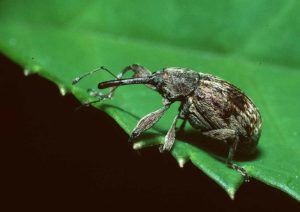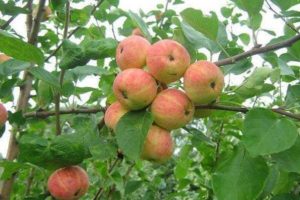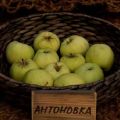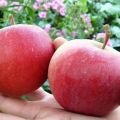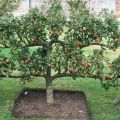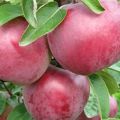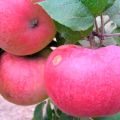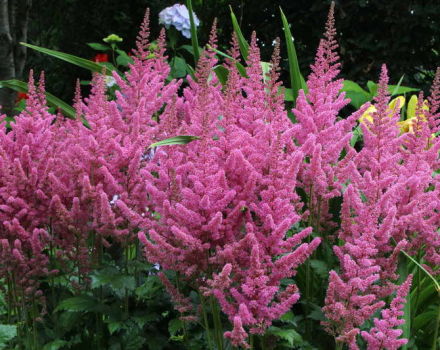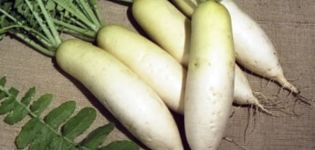Description and characteristics of the apple variety Autumn joy, cultivation and yield
The Autumn Joy apple tree is a suitable fruit tree for cultivation in the local economy. After removal, the fruits retain their taste for a long time, remaining aromatic and juicy even in winter. The advantage of the variety is that it grows in places not suitable for gardening, it is winter hardy and has a strong immunity to disease.
Description of the variety Autumn joy
The hybrid was created by gradual pollination. The mother variety was "Wellsey". Since the apple tree grew on poor soil, it developed resistance to low temperatures and infections. She grows tall, has a spreading crown and round shapes. The bark is brown, the shoots are large and straight, slightly drooping. The stems are decorated with yellow lentils. They are round and elongated. The kidneys are gray, large.
The apples of Autumn Joy are concentrated on the fruit twigs. When describing the variety, it is noted that the ovoid green leaf is covered with wrinkles, along the edges - waves. The approximate weight of the fruit is about 110-135 g. The fruits have a regular round shape, elongating towards the top. They turn out green, with a burgundy blush and barely noticeable strokes. A gray spot is visible on the surface.
A small peduncle protrudes behind a wide and shallow funnel with a small rustiness.
Apple seeds of the Autumn Joy variety are colored brown-red. The cups are small, closed. The sub-cup tube is small and conical.
What kind does it belong to
The apple tree belongs to the autumn species. You can harvest the fruits at the end of August. By the beginning of autumn, apples ripen, filling with juice. They stay on the tree for a long time without losing their attractiveness and taste. If placed in a cool place, the apples can be stored for up to 60 days. Insects pollinate apple trees of the Autumn Joy variety. They are attracted by the sweet smell of the apple tree.
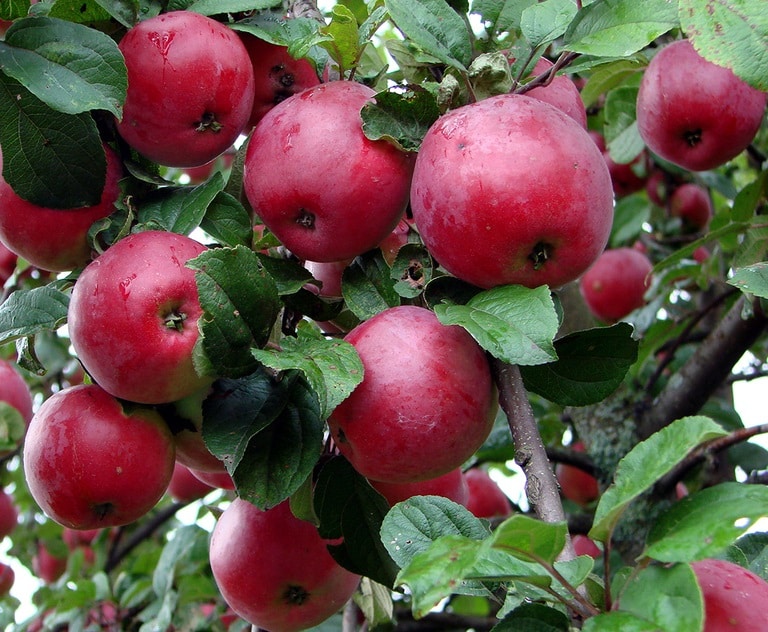
Breeding history
In 1948, the breeder S.I. Isaev selected 15 Welsey trees and carried out a two-stage pollination. First, the paternal variety Brown striped became the pollinator, then the maternal one. The process ended in success: Isaev bred the seeds of Autumn joy. They were stratified for 4 months before landing. It went well. When growing an apple tree, the mentor's method was used.
The variety was hardened in poor soils, due to which it has an amazing resistance to diseases.
Region of natural growth
The hybrid has become popular in Ukraine and Belarus.Although the variety feels great in a harsh climate, it is not recommended to grow it in Siberia.
But initially the hybrid was intended for cultivation in such regions of Russia:
- Ivanovskaya;
- Moscow;
- Smolenskaya;
- Ryazan;
- Tula;
- Kaluga;
- Vladimirskaya;
- Tverskaya;
- Bryansk;
- Yaroslavl.
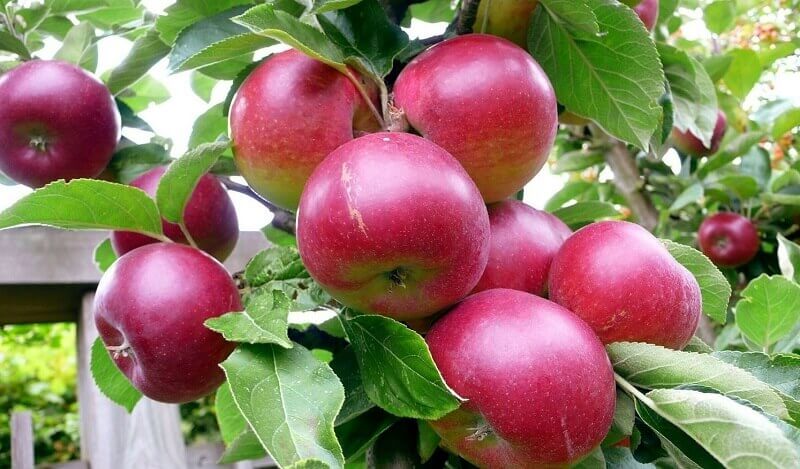
In case of heat and drought, the apple tree must be watered periodically. In the spring, nutrients must be added to the soil in a dissolved form. It is unrealistic to do this in dry soil. It should be watered abundantly, otherwise the depletion of the tree cannot be avoided.
The apple tree grows well in cold conditions. To speed up adaptation, it can be fed. For young trees, the recommended frequency of the procedure is twice a year, for adults - 1 time. Better to use organic fertilizers.
Variety characteristics
The Autumn Joy variety is widely used in breeding. Thanks to him, NIIS created new hybrids - Cherished and Firebird. Amateur gardeners are sure that the variety is superior to Medunitsa, Aelita, Young Naturalist in taste and appearance.
The apple tree is susceptible to diseases such as black cancer, cytosporosis, fire blight.
It can be damaged by pests:
- hawthorn;
- green aphid;
- apple moth.

Disinfection and spraying with actellik, enterobacterin will help. You need to take care of the tree comprehensively, from early spring to late autumn. In the spring, you should examine the tree, heal wounds, treat it from insects. In the fall - whitewash and feed.
Advantages and disadvantages
Minus in poor tree branching, branching off at an acute angle, fragility of branches in young apple trees growing in warm conditions.
Among the advantages of the variety are:
- Frost resistance.
- Dessert taste.
- Attractive shape.
- Large size.
- Abundance of crops.
- Weak disease.
Dimensions of the tree
The apple tree is tall. If it is not formed, it can grow up to 12 meters. Breeders note that the annual growth rate is weak.
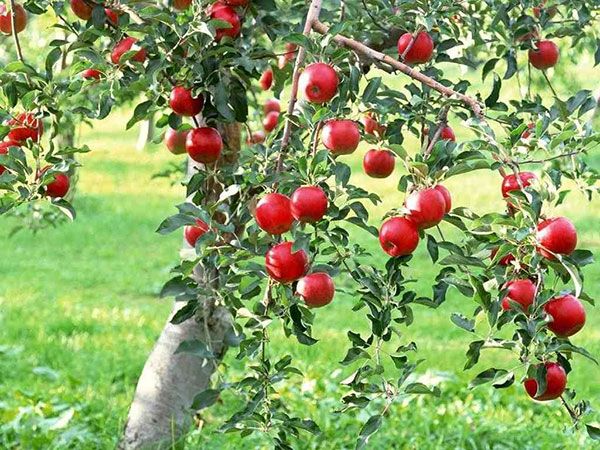
Productivity and frequency of fruiting
The difference between the autumn joy variety is its high, but not regular yield. Flowering begins in May. Its duration depends on the temperature. One tree can please 90 kg of fruit.
Apple trees that have reached 20 years of age give 60 kg more fruit. Fruiting begins in the fourth to fifth year after planting. The first bountiful harvest occurs at year 7. Although the fruits are firmly attached to the stems, you should not delay picking them: ripe apples fall off. The apple tree bears fruit every year.
Tasting assessment
Due to its sweet, pronounced taste, the variety received a tasting rating of 4.3 points. Apples have beige flesh of sweet and sour taste, with notes of spice.
It contains:
- sugars - 10.2%;
- dry matter - 12.6%;
- titrated acids - 0.3%.

The structure of the fruit is tender and rich, of medium density. They can be eaten fresh or used for preservation.
Winter hardiness and disease resistance
The apple tree is not afraid of low temperatures and scab. In terms of winter hardiness, it has the same indicators as the paternal variety Brown striped. In especially harsh winters, the apple tree can freeze slightly. This is especially true for perennial wood. The tree is recovering quickly.
Landing features
The apple tree should not coexist with other fruit trees... You need to plant it in an open and well-lit place. The best time for this is March or April. A week before landing, you need to prepare. The seedlings are laid in holes 60 cm deep and 1 m wide. The soil is fertilized before this, and after planting, it is watered abundantly. This promotes good rooting.
